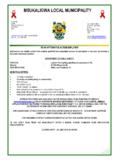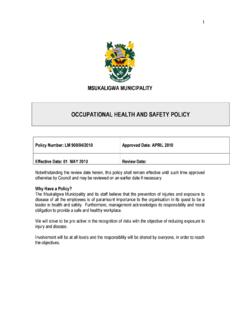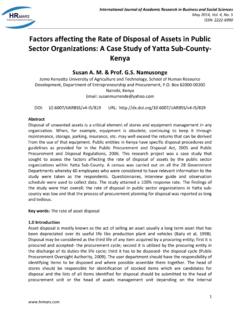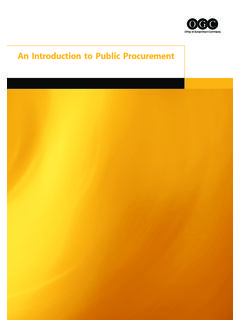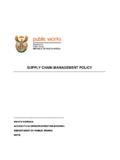Transcription of ASSET MANAGEMENT POLICY - Msukaligwa Local …
1 ASSET MANAGEMENT POLICY Msukaligwa MUNICIPALITY 1. INTRODUCTION This POLICY document is deemed necessary in order to facilitate the effective MANAGEMENT , control and maintenance of the assets. This document will be subjected to further changes. 2. AIMS / OBJECTIVES OF THE POLICY The objectives of the ASSET MANAGEMENT POLICY is to ensure that the assets of the Msukaligwa Municipality are properly managed and accounted for by: (i) Ensuring the accurate recording of ASSET information; (ii) The accurate recording of ASSET movements; (iii) Exercising strict physical control over all assets (Security, safekeeping, housekeeping); (iv) Providing correct and meaningful MANAGEMENT information in conjunction with other disciplines and functions which, inter alia, includes Insurance; (v) Compliance with Council s Insurance POLICY and Payment Procedure; (vi) Effecting adequate insurance of all assets.
2 (vii) Maintenance of Council s Assets. 3. DEFINITIONS Assets are defined as follows: Assets include land, buildings engineering works, machinery, equipment, vehicles, office furniture and equipment, but would exclude minor items that are generally regarded as expendable, even though their useful lives may extend beyond one year, pens, files and note pads. RECOGNITION OF AN ASSET An ASSET is recognized when it is probable that the future economic benefits or potential service provision will flow to Council and the ASSET has a cost or value that can be reliably measured. Heads of Departments is defined as follows: All Directors in the different directorates.
3 DEFINITIONS ACCORDING TO GAMAP PROPERTY, PLANT AND EQUIPMENT are tangible assets that: (a) are held by a municipality for use in the production or supply of goods or services, for rental to others, or for administrative purposes, and (b) are expected to be used during more than one period. INFRASTUCTURE ASSETS are defined as any ASSET that is part of a network of similar assets. Examples are roads, water reticulation schemes, sewerage purification and trunk mains, transport terminals and car parks. COMMUNITY ASSETS are defined as any ASSET that contributes to the community s well-being. Examples are parks, libraries and fire stations. HERITAGE ASSETS are defined as culturally significant resources.
4 Examples are works of art, historical buildings and statues. INVESTMENT PROPERTIES are defined as properties that are acquired for economic and capital gains. Examples are office parks and undeveloped land acquired for the purpose of resale in future years. OTHER ASSETS are defined as assets utilized in normal operations. Examples are plant and equipment, motor vehicles and furniture and fittings. DEPRECIATION is the systematic allocation of the depreciable amount of an ASSET over its useful life. DEPRECIABLE AMOUNT is the cost of an ASSET , or other amount substituted for cost in the financial statements, less its residual value. USEFUL LIFE is either: (a) the period of time over which an ASSET is expected to be used by the municipality, or (b) the number of production or similar units expected to be obtained from the ASSET by the municipality.
5 COST is the amount of cash or cash equivalents paid or the fair value of the other consideration given to acquire an ASSET at the time of its acquisition or construction. RESIDUAL VALUE is the net amount that the municipality expects to obtain for an ASSET at the end of its useful life after deducting the expected costs of disposal . FAIR VALUE is the amount for which an ASSET could be exchanged between knowledgeable, willing parties in an arm s length transaction. RECOVERABLE AMOUNT is the amount that the municipality expects to recover from the future use of an ASSET , including its residual value on disposal . 4. RESPONSIBILITY (PHYSICAL CONTROL OF ASSETS) The responsibility for the physical control of assets rests with the relevant directorate/department responsible for the specific ASSET .
6 The Finance Department must financially substantiate the assets as per Financial Statements and participate in the process of physical control to achieve accurate and reliable ASSET information with regards to purchases, write-offs, transfers, donations and locations. Although certain responsibilities have been allocated to certain levels of MANAGEMENT , within the ASSET MANAGEMENT POLICY , the ultimate responsibility to ensure control over each ASSET in terms of the POLICY remains with Heads of Departments. The system, in as far as the maintenance and MANAGEMENT of assets for all the departments / directorates shall be the same. Each Department shall ensure that assets entrusted to it are adequately maintained and properly used.
7 AUTHORITY AND DELEGATED POWERS Heads of Departments must approve/recommend all ASSET movements which relate to: (i) Writing-off of items (approval by the Municipal Manager). (ii) Transfer of items (inter departmental transfers). The Director Finance and where necessary his/her duly designated official shall: (i) Ensure implementation of the approved ASSET MANAGEMENT POLICY ; (ii) In consultation with the Directors verify assets in possession of the Council annually, as at 30 June of a particular financial year, within the last two months of the financial year; (iii) Provide the Municipal Manager with a detailed outcome report on the assets verification exercise; (iv) Keep a complete and balanced record of all assets in possession of the Council; (v) Report in writing all ASSET losses to the Council; (vi) Ensure that the ASSET register of the Council is balanced at least annually.
8 NB: Each Department / Directorate must keep an accurate record of all ASSET losses and report such losses to the Director of Finance. 5. DEPRECIATION The straight-line method of depreciation will be used. 6. COMPOSITION OF ASSET REGISTER The ASSET Register shall contain the following categories: CATEGORISATION OF ASSETS The categorization of assets in the ASSET register will be as per the Generally Accepted Municipal Accounting Standards Guidelines: Infrastructure Assets Community Assets Heritage Assets Investment Properties Other Assets Details of the assets listed with useful lives are attached as Annexure A1.
9 THE INVENTORY REGISTER The purpose of this register is to record and maintain all inventory purchases and movements, with a value less than R1 000,00. 7 TYPES OF ASSETS All types of assets will be categorized as per point above. 8 ACQUISITION OF ASSETS HOW ARE ASSETS ACQUIRED? The process to be followed when assets are acquired shall be in accordance with the Council s Procurement, Delegation of Authority Policies and Payment Procedures. This shall apply to all the types of Council s assets as contained in Sections 5 and 6 of this POLICY . Depending on the amount of the ASSET to be purchased and after the necessary authorization has been obtained the following procedure for purchasing an ASSET must be followed: - Requisition to be completed and signed by person requesting the ASSET ; - Quotations, for example (procurement POLICY ) must be attached to requisition; - Order to be generated by the Finance Department : Creditors Section; - Delivery of the ASSET purchased; - Labeling/Bar coding of the item purchased; - Arrival of invoice from the supplier; - Endorsing of the invoice with the bar code of the ASSET ; and - Payment is generated.
10 The Finance Department will provide the Head of Departments with a monthly report on ASSET movements. The reporting must also apply to the following: (i) Donations. (ii) Additions / Improvements (refers to immovable assets). (iii) Auctions. (iv) Loss or damage. (v) Transfers. (vi) Write-offs. (vii) Land sales. Heads of Departments: (i) Shall at all times ensure that there are enough funds in the budget before approval of any requisitions. (ii) Shall ensure that the correct vote and description are being used before authorizing any requisitions. 9 disposal OF ASSETS All assets to be disposed of by public auction. The Council shall give fourteen (14) days notice in the newspaper circulating within its area.


